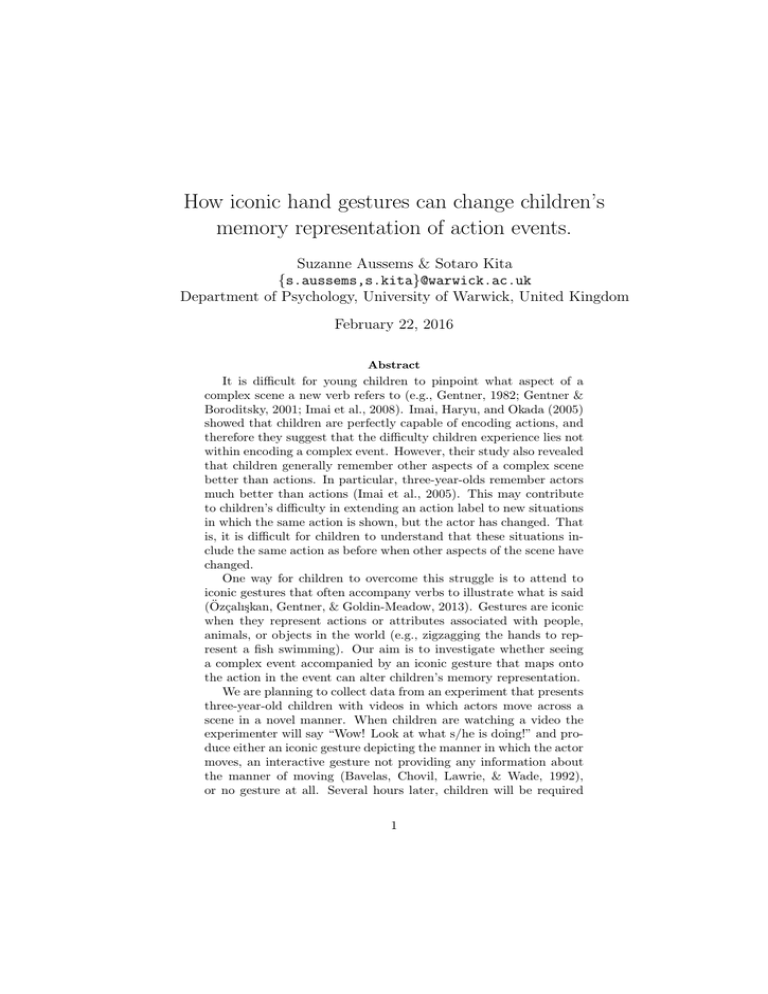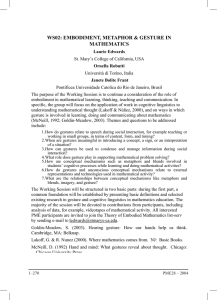How iconic hand gestures can change children’s
advertisement

How iconic hand gestures can change children’s
memory representation of action events.
Suzanne Aussems & Sotaro Kita
{s.aussems,s.kita}@warwick.ac.uk
Department of Psychology, University of Warwick, United Kingdom
February 22, 2016
Abstract
It is difficult for young children to pinpoint what aspect of a
complex scene a new verb refers to (e.g., Gentner, 1982; Gentner &
Boroditsky, 2001; Imai et al., 2008). Imai, Haryu, and Okada (2005)
showed that children are perfectly capable of encoding actions, and
therefore they suggest that the difficulty children experience lies not
within encoding a complex event. However, their study also revealed
that children generally remember other aspects of a complex scene
better than actions. In particular, three-year-olds remember actors
much better than actions (Imai et al., 2005). This may contribute
to children’s difficulty in extending an action label to new situations
in which the same action is shown, but the actor has changed. That
is, it is difficult for children to understand that these situations include the same action as before when other aspects of the scene have
changed.
One way for children to overcome this struggle is to attend to
iconic gestures that often accompany verbs to illustrate what is said
(Özçalışkan, Gentner, & Goldin-Meadow, 2013). Gestures are iconic
when they represent actions or attributes associated with people,
animals, or objects in the world (e.g., zigzagging the hands to represent a fish swimming). Our aim is to investigate whether seeing
a complex event accompanied by an iconic gesture that maps onto
the action in the event can alter children’s memory representation.
We are planning to collect data from an experiment that presents
three-year-old children with videos in which actors move across a
scene in a novel manner. When children are watching a video the
experimenter will say “Wow! Look at what s/he is doing!” and produce either an iconic gesture depicting the manner in which the actor
moves, an interactive gesture not providing any information about
the manner of moving (Bavelas, Chovil, Lawrie, & Wade, 1992),
or no gesture at all. Several hours later, children will be required
1
to point out the video that they watched before in a forced-choice
paradigm where previously shown videos are paired up with distractor videos that either present the same actor doing a different action,
or a different actor doing the same action. If children choose the
videos that they have seen before over the distractor videos in which
the actor or action has changed, then this indicates they remembered the actions and actors, respectively. We predict that children
in the iconic gesture condition have a better memory for actions and
a worse memory for actors than children in the interactive gesture
and no gesture conditions.
We aim to present the results of this experiment at the conference
and discuss the implications of the role of gesture in memory and
verb learning.
Keywords: Iconic gestures; action memory; actor memory; recognition task.
References
Bavelas, J., Chovil, N., Lawrie, D., & Wade, A. (1992). Interactive gestures.
Discourse Processes, 15 , 269–189. doi: 10.1080/01638539209544823
Gentner, D. (1982). Why nouns are learned before verbs: Linguistic relativity
versus natural partitioning. In S. Kuczaj (Ed.), Language development:
Vol. 2. Language, thought and culture (pp. 301–334). Hillsdale, NJ: Erlbaum.
Gentner, D., & Boroditsky, L. (2001). Individuation, relational relativity and
early word learning. In M. Bowerman & S. Levinson (Eds.), Language
acquisition and conceptual development. Cambridge, England: Cambridge
University Press.
Imai, M., Haryu, E., & Okada, H. (2005). Mapping novel nouns and verbs
onto dynamic action events: are verb meanings easier to learn than noun
meanings for Japanese children? Child Development, 76 (2), 340–55. doi:
10.1111/j.1467-8624.2005.00849 a.x
Imai, M., Li, L., Haryu, E., Okada, H., Hirsh-Pasek, K., Golinkoff, R., & Shigematsu, J. (2008). Novel noun and verb learning in Chinese-, English-, and
Japanese-speaking children. Child Development, 79 (4), 979–1000. doi:
10.1111/j.1467-8624.2008.01171.x
Özçalışkan, S., Gentner, D., & Goldin-Meadow, S. (2013). Do iconic gestures
pave the way for children’s early verbs? Applied Psycholinguistics, 35 (6),
1–20. doi: 10.1017/S0142716412000720
2





